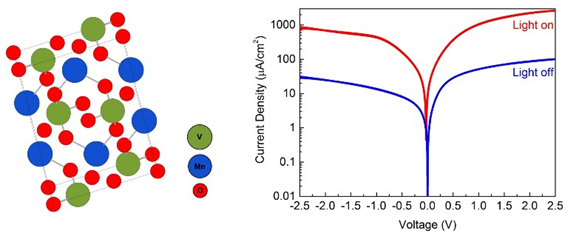In conventional devices oxides are used only as insulating materials. However, oxides is a very large class of materials, much larger than the class of elemental semiconductors, which show every electromagnetic property known to science, including superconductivity, ferroelectricity, semiconductivity, & photoconductivity. The challenge is identifying the “right” oxide for an application and then finding the “correct” way of fabricating a device. Collaborating with computational physicists and materials scientists, we first identify novel metal-oxides tailor-made for an application. Next, we find novel methods of depositing oxides thin-films. CeNSE has developed some unique deposition tools, such as a combined PLD + sputtering system, plasma-enhanced ALD, modular PLD, and microwave-assisted low-temperature CVD, which allow fabrication of virtually any type of metal-oxide thin-film on a range of substrate and deposition temperatures. Finally, we make oxide devices such as diodes, thin-film transistors, non-volatile memory pixels, and solar cells.
1. Stress Engineered Metal-Oxides on Silicon
CeNSE boasts of an indigenously designed system designed to study stress evolution in-situ during growth of oxide films on Si by both PLD and sputtering. This combination of capabilities makes it the first and only experimental set of its kind in India and possibly in the whole world. System is used to deposit strain engineered oxides on silicon, akin to strain engineered Si-Ge found in current computer chips, which are expected to play a key role in “system-on-chip” and “Beyond Si” applications.

2. Si/Metal-oxide Heterojunction
The 2015 semiconductor roadmap envisages that from 2022 onwards conventional CMOS will reach its limit and alternative material will be needed to drive further progress. Even in photovoltaics, conventional p-n junction solar cells are reaching the limit of efficiency, and researchers are increasingly looking at heterojunction solar cells. In this new paradigm, the Si wafer remains but the active area of the device shift from bulk of silicon to the interface between Si and “something” else. Oxides are prime candidates for this “something” else and at CeNSE we have successfully demonstrate several Si/oxides heterojunction devices, e.g. Si/TiO2 and Si/Cu2O.

Si/Cu2O heterojunction for High EfficiencyPhotovoltaics
Representative Publications
i) P. Ravindra, R. Mukherjee, S. Avasthi, “Hole-Selective Electron-Blocking Copper Oxide Contact for Silicon Solar Cells," accepted for publication in IEEE Journal of Photovoltaics.
ii) K. A. Nagamatsu, S. Avasthi, G. Sahasrabudhe, G. Man, J. Jhaveri, A. Berg, J. Schwartz, A. Kahn, S. Wagner, J. C. Sturm, “Titanium dioxide/silicon hole-blocking selective contact to enable double-heterojunction crystalline silicon-based solar cell," Applied Physics Letters 106, 123906 (2015).
iii) S. Avasthi, W. McClain, G. Man, A. Kahn, J. Schwartz, and J. C. Sturm, “Hole-Blocking Titanium-Oxide/Silicon Heterojunction and its Application to Photovoltaics,” Applied Physics Letters 102, 203901 (2013).
3. Solar radiation absorbers
Compared to other thin-films semiconductors, such as organics and hybrid perovskites, typical metal-oxides are much more stable. A large portion of metal-oxides are also low-cost. This combination makes them interesting candidate for low-cost a long-lasting solar cells. Under a new initiative in CeNSE, we are using computational and experimental methods to scan the periodic table in search of metal-oxide semiconductors for thin-film solar cells

Structure of Mn2V2O7 (MVO) a novel low-bandgap oxide that is photoactive
Representative Publications
i) P. Ravindra, E. Athresh, R. Ranjan, S. Raghavan, S. Avasthi, “Effect of Annealing on Performance of Solar Cell with New Oxide Absorber Mn2V2O7," 44th IEEE Photovoltaic Specialists Conference, Washington D. C., June 2017
ii) P. Ravindra, E. Athresh, R. Ranjan, S. Raghavan, S. Avasthi, “Electro-optical Properties of Zn2Mo3O8 Thin-Films: A Novel Low-Bandgap Solar Absorber," 44th IEEE Photovoltaic Specialists Conference, Washington D. C., June 2017
|
Associate Professor |